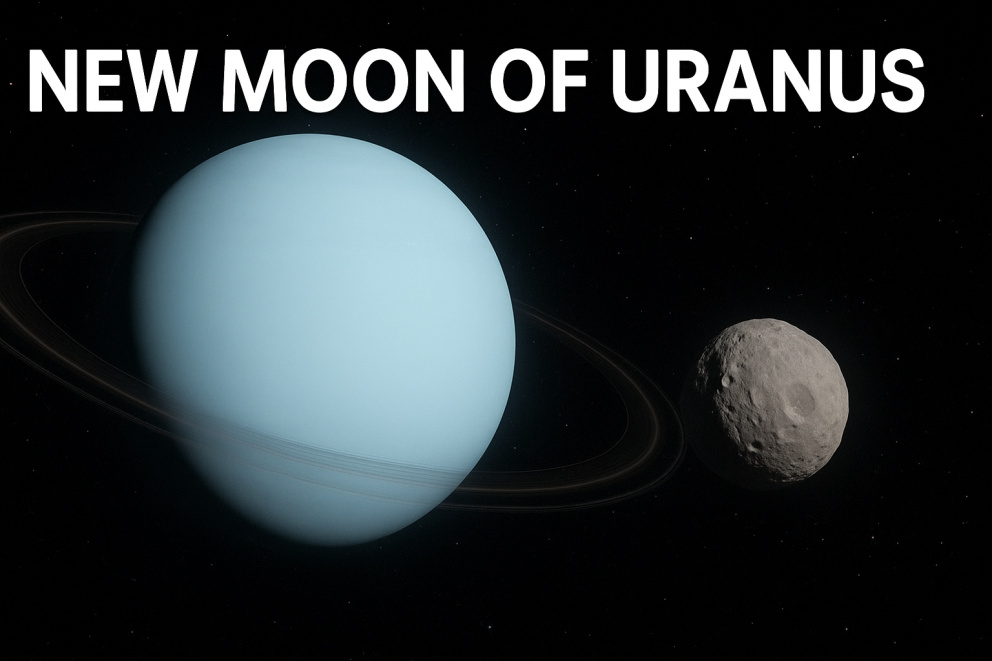Hidden Moon of Uranus Discovered by Astronomers
Astronomers have made an exciting discovery in our solar
system—a hidden moon orbiting Uranus. This breakthrough sheds new light
on one of the most mysterious planets in our cosmic neighborhood. While Uranus
has long fascinated scientists for its unusual tilt and icy composition, the
recent detection of an additional moon makes the planet even more intriguing.
In this article, we’ll explore what scientists found, how
this hidden moon was detected, why it matters, and what it reveals about the
Uranian system.
Uranus
and Its Moons: A Quick Overview
Uranus is the seventh planet from the Sun and one of
the coldest in the solar system. Unlike most planets, Uranus rotates on its
side, likely the result of a massive collision billions of years ago. This
unique tilt gives Uranus extreme seasons, each lasting over 20 Earth years.
Until now, astronomers had confirmed 27 moons of Uranus,
with names inspired by characters from the works of William Shakespeare and
Alexander Pope. The largest moons—Titania, Oberon, Ariel, Umbriel, and
Miranda—are icy worlds with complex terrains. The newly discovered hidden
moon adds to this fascinating collection, showing us that Uranus still holds
secrets waiting to be uncovered.
How
Astronomers Discovered the Hidden Moon
The discovery came from careful analysis of high-resolution
images taken by powerful telescopes and re-examined data from past space
missions. Using advanced imaging technology, astronomers spotted a faint object
moving consistently with Uranus’s gravitational pull.
What makes this discovery remarkable is that the moon had
remained undetected for decades, hidden by its small size and faint
brightness. Researchers believe the moon is only a few kilometers
across—tiny compared to Uranus’s larger satellites. Its faint glow blended
with the background of stars, making it nearly invisible until now.
Why This
Discovery Matters
The identification of a hidden moon is more than just adding
another name to Uranus’s moon count—it has scientific significance:
- Understanding
Planetary Formation
- Studying
small moons helps scientists piece together how giant planets like Uranus
formed and evolved. These smaller bodies may be remnants from the planet’s
early history.
- Gravitational
Influence
- Even
tiny moons can shape the planet’s rings and affect the orbits of other
satellites. Learning about this moon’s movement could explain some of
Uranus’s unusual ring patterns.
- Clues
About the Solar System’s Past
- Each
new discovery provides insights into the dynamic history of the solar
system, including collisions, captures, and migrations of moons.
Could
There Be More Moons Around Uranus?
The detection of this hidden moon raises the exciting
possibility that Uranus may have many more undiscovered satellites. Some
could be too small or faint for current telescopes to detect.
Future space missions, such as potential flybys or orbiters
dedicated to Uranus, could reveal a richer and more complex moon system than we
currently know. NASA and other space agencies have already discussed sending a Uranus
orbiter mission in the 2030s, which could provide detailed observations of
the planet, its rings, and its moons.
What We
Know About the New Moon So Far
While scientists are still studying the discovery, early
observations suggest:
- The
moon is very small, likely just a few kilometers across.
- Its
orbit is relatively stable, moving in sync with Uranus’s gravitational
field.
- It
may influence the planet’s faint ring system, helping explain
certain irregularities seen in Uranus’s rings.
- Its
composition is likely icy, similar to other Uranian moons.
Because of its size, this hidden moon may never host robotic
landers, but it will remain an important subject of study for astronomers.
The
Broader Importance of Moon Discoveries
Finding moons around planets isn’t just about adding new
celestial bodies to a list—it helps us understand the diversity of planetary
systems. By studying moons, astronomers can answer big questions:
- How
did planets and their satellites form?
- How
stable are planetary systems over billions of years?
- Could
moons provide conditions suitable for life?
In fact, several moons in the solar system, like Europa
(Jupiter) and Enceladus (Saturn), are prime candidates in the search for
extraterrestrial life. While Uranus’s newly found moon is too small and icy
for life, its discovery is a step toward a deeper understanding of the hidden
dynamics of our solar system.
What’s
Next for Uranus Exploration?
For decades, Uranus has been one of the least-explored
planets in our solar system. Only a single spacecraft, Voyager 2,
visited Uranus in 1986, providing our first close-up look. Since then, most
knowledge has come from Earth-based telescopes.
The discovery of this hidden moon adds to the growing call
for a dedicated mission to Uranus. An orbiter could map its moons, study its
rings, and uncover more hidden secrets. With advancing technology, the next
decade may finally bring a closer look at this icy giant.
Conclusion
The discovery of a hidden moon orbiting Uranus is a
reminder that the solar system is still full of mysteries. Even in the 21st
century, with powerful telescopes and decades of exploration, we continue to
uncover new worlds in our own cosmic backyard.
As astronomers study this tiny moon, we’ll gain fresh
insights into the history of Uranus, its complex moon system, and the evolution
of planets in general. One thing is clear: Uranus is far from fully understood,
and the best discoveries may still lie ahead.









